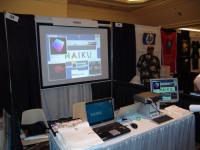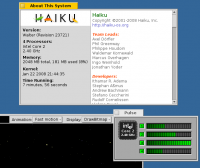A nice overview in mind map format, for those of you interested.
Here’s a summary of the last 3 weeks in Haiku-land. Axel was off skiing for part of this period, but progress has continued apace (and Axel has still managed to make his way into almost all of my update sub-sections!).
Highlights include progress towards self-hosting, a new kernel allocator that is much faster and more scalable, improved VMware Image support in the build system, automatic syscall restarts, and the usual raft of bug fixes, stability updates and interface tweaks.
Here are some screenshots of what I fixed at FOSDEM…
Hi there from our FOSDEM booth in the corridor!

 Haiku booth ready for the showThis past weekend Bruno G. Albuquerque, Joe Bushong and myself represented Haiku at the sixth Southern California Linux Expo conference, best known as SCaLE 6x, held on February 9 and 10 in the city of Los Angeles. This was the second year in a row that we organized a presence for Haiku at this event, and since we had so much fun last year (here are two reports and photos from 2007), we were all looking forward to doing it again this time around.
Haiku booth ready for the showThis past weekend Bruno G. Albuquerque, Joe Bushong and myself represented Haiku at the sixth Southern California Linux Expo conference, best known as SCaLE 6x, held on February 9 and 10 in the city of Los Angeles. This was the second year in a row that we organized a presence for Haiku at this event, and since we had so much fun last year (here are two reports and photos from 2007), we were all looking forward to doing it again this time around.
I picked up Bruno from San Francisco airport on Wednesday February 6 at around midnight; he was supposed to arrive a few hours earlier, but he missed his connection flight in New York. The next day, Bruno and I prepared everything for the booth, including setting up our own demo machines (he had Haiku running in VMWare on a MacBook Pro, I had it running natively on my HP Pavilion zv5000 laptop), testing the projector with my (oldish) small cube computer running an AMD XP 1.7G CPU with 1GB RAM, and finishing up and printing the Haiku flyers to handout at the booth. We also could not resist the temptation, and ended up buying a projector screen (we split the cost) so that we could show Haiku running on the backwall of the booth. My wife also did her part, and volunteered to iron and nicely fold about 15 Haiku t-shirts to sell at the booth. By dinner time, we had almost everything ready.
 Multi-processor support has been improvedI managed a whole three Activity Update posts last summer before Real Life (TM) got in the way. Ironically #3 mentioned switching to a two-week update to be more resilient to stuff in the real world! Well, 2 weeks has become 4 months but I'm back on top of all things Haiku and ready to once again attempt to provide a bi-weekly update.
Multi-processor support has been improvedI managed a whole three Activity Update posts last summer before Real Life (TM) got in the way. Ironically #3 mentioned switching to a two-week update to be more resilient to stuff in the real world! Well, 2 weeks has become 4 months but I'm back on top of all things Haiku and ready to once again attempt to provide a bi-weekly update.
It is stating the obvious to say that a lot has happened in the Haiku world in the last 4 months (my email backlog had grown to over 4000 emails) and so this update will cover less detail than the more regular ones and will mainly focus on the changes that have happened in the Haiku code.
In brief: Huge stability improvements in the kernel and VM, syscall optimisations, OHCI USB work, an AHCI SATA driver, hotplugging support for devices, USB 2.0 handling for legacy devices, work on partitioning support and DriveSetup, and new features in Kernel Debugging Land.
Read on for more...
What to do when you are bored at 1 am, and you see noone sending in new themes ? Make sure you can use more of the existing ones :)
I’ve never used BeTheme myself, but it seemed to have gained some fans. So hoping it would bring newer ideas I added some code to the Theme manager to import those themes. It currently supports background pictures, deskbar position and R5 decor.
Some people might wonder what exactly this “themes” stuff in the commits is all about. So let’s see how it all started, where we are and what’s left to do.
Features The Theme Manager is an addon-based desktop theme selector. It can selectively apply parts of a theme, create a new one based on the current configuration, add a screenshot to it.
Currently, themes contain settings for ui colors, system fonts, background pictures, window decorator, deskbar position, screensaver, Terminal colors, font and size, sounds, and even the selected winamp skin from CL-Amp and SoundPlay through a specific plugin.
As I write this first post, I’m in the process of sending off the initial OpenJDK project page content to Mark Reinhold for public posting. I’m grinning wildly, and I’m having some great flash-back style memories of working on the JDK 1.4 port.
I think now is a good time for a general status report, to communicate where we’re at, where we’re going, how we’ll get there, and how you can get involved.
To be honest, I was a bit desperate in the run up to BeGeistert 018. The fact that most of our core contributors were present gave me high hopes for a good push of Haiku development. Since my laptop was stolen, which was a really solid Haiku machine, I could not run Haiku natively on my main development computer. Even on some older computers I had, I could not run it anymore since the initial changes to the IDE stack. Next was the fact that I bought a new USB based KVM switch. The only USB stack with which I had a working keyboard and mouse was the original Dano stack. And even then I sometimes lost input when switching back to BeOS from another computer. With Haiku, the input devices were not working at all. So I was packing both my computer, monitor and the KVM switch for BeGeistert, all in all, it was quite a load. I was heading towards BeGeistert with a bit of mixed feelings, because Haiku wasn't working so well for me anymore and I didn't know if it was going to be fun only or with some disappointments mixed in.






